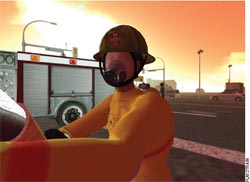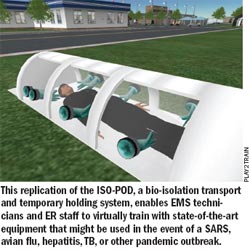Virtual Preparedness
If your real-life emergency training is a logistical nightmare, consider Second Life.
 By now you have probably heard of Second
Life, the online community created by San
Francisco-based Linden Lab in which people,
or their animated representatives, can
buy virtual “goods” and “land,” construct homes and
buildings, conduct business, and essentially live second,
imaginary lives—spending, and sometimes making, real
money in the process. The Web site (or “World”) has
been alternately described as “some unholy offspring of
the movie The Matrix, the social networking site My
Space.com, and the online marketplace eBay”1 and “the
perfect capitalist system in which you pay for fake stuff
(clothing, housing, hookers) with real money.”2 Linden
Lab itself describes its creation as “a vast digital continent,
teeming with people, entertainment, experiences,
and opportunity.”
By now you have probably heard of Second
Life, the online community created by San
Francisco-based Linden Lab in which people,
or their animated representatives, can
buy virtual “goods” and “land,” construct homes and
buildings, conduct business, and essentially live second,
imaginary lives—spending, and sometimes making, real
money in the process. The Web site (or “World”) has
been alternately described as “some unholy offspring of
the movie The Matrix, the social networking site My
Space.com, and the online marketplace eBay”1 and “the
perfect capitalist system in which you pay for fake stuff
(clothing, housing, hookers) with real money.”2 Linden
Lab itself describes its creation as “a vast digital continent,
teeming with people, entertainment, experiences,
and opportunity.”
That the site is “teeming” is not in doubt. Since it
opened to the public in 2003, the number of people
using Second Life has never gone down. By the end of
June,by Linden Lab’s own tally, the number of total participants
(or Residents, as it calls them) was 14,158,048,
some 840,000 of whom were logged-in during the
month. By one count, between 31,000 and 65,000 Residents
are logged-in at any given second of the day.
Included in this cyber-population is Rameshsharma
Ramloll, Ph.D., a research assistant professor at
Idaho State University in Pocatello. Ramloll’s background
is in engineering and computer science, but as
the technological director for Play2Train—a virtual
training space in Second Life designed for conducting
emergency preparedness exercises—he also is something
of a Second Life expert, and he says there is far
more to it than merely the sexual role playing, shopping,
and real estate you hear about, although all those
aspects of it are alive and well.
“I think Second Life is not well represented or well
explained in the media,” Ramloll says. “To me, the single
most active community in Second Life is the education
community—and, in fact, Second Life would not
be what it is today without it. You have hundreds of universities
building virtual campuses and lots of experimentation—
people looking at how you can actually
create on-the-fly models of molecules, for example—
people working with, visualizing data in real time.”
Islands in the Cyberstream
For the past two and half years—or roughly half of Second
Life’s life—Ramloll has overseen all operations, virtual
and otherwise, of Play2Train using Second Life’s
wealth of graphics applications and other techno tools
to build synthetic environments in which companies
can conduct their various online ER drills. Those who
design the actual training that plays out in Ramloll’s creations
are subject matter experts he hires as consultants,
many of whom he has met “in-World.” Ramloll maintains
full control over who gets access to the otherwise
private town and two hospitals built on the three islands
that currently comprise Play2Train’s presence on the
Second Life platform.
Up until last month, all business conducted on the
Play2Train site was funded by a grant from the U.S.
Department of Health & Human Service’s Office of the
Assistant Secretary for Preparedness and Response
(ASPR) in support of the Idaho Bioterrorism Awareness
and Preparedness Program, of which Play2Train
is part. Because of the grant, Ramloll has been able to
create the various training projects without worrying
much about the costs involved for either Play2Train or
the various federal agencies and private companies
who have been the site’s “partners,” but he estimates his
team’s efforts to date would likely cost “in the millions.”
Because the ASPR funding ended in August for the first
time in Play2Train’s life, Ramloll says he has been “exploring
new ways to monetize all we are doing, because we need to keep this effort going. These are the things
that have been keeping me awake at night.”
 High Fidelity
High Fidelity
Ramloll is the first to admit that training carried out on
a computer screen has its limitations, but he also strongly
contends that it has its place and that its benefits far
outweigh the perceived drawbacks. He cites the airline
industry’s standard practice of using flight simulators as
one area in which virtual environments are deployed for
very high levels of comparatively cost-effective training,
and he sees the types of ground disaster preparedness
scenarios he constructs as being similarly effective, and
eventually similarly accepted.
In terms of cost-effectiveness, for example, unlike
real-life disaster preparedness training, which can necessitate
shutting down a whole facility or section of
town and thus can take place only once every year or
two and even then at high cost, virtual training can
be conducted as often as needed—on weekends, at
night—with virtually no disruption to normal business
schedules. And he notes that as a tool for competency
evaluation, virtual training allows managers
easily to determine whether employees are at the level
of preparedness they
need to be prior to deploying
real-life, full-scale
training.
From a networking
perspective, Ramloll
adds that nothing is
easier than conducting
online, in-World business
between agencies
from various states or
even other parts of the
world. “We never say
we are going to create
virtual environments
for training to replace
any face-to-face training
or any full-scale exercises,”
he says. “We create these virtual environments
to create more opportunity for interactions between
people who are involved in the exercises, so whatever
they learn in those virtual environments can be used to
complement any of the full-scale exercises they might
have in the real world.”
Having created a number of these virtual
environments, Ramloll says that an unexpected
benefit to trainees is that their participation
allows them to use, albeit virtually,
the latest in emergency preparedness equipment
for the first time. “This is equipment
that would cost millions of dollars even for
the state to buy,” he says. “So, from the perspective
of bringing state-of-the-art emergency
awareness products to the eyeballs of
people who might not have seen it otherwise,
this also is a big plus.”
Examples of such high-dollar “products”
are in abundance in one Play2Train
project that involved creating an exact, 3-D
replica of the Elk’s Rehabilitation Hospital
in Boise that Elk’s staff were later able to use
to conduct evacuation and disaster drills.
The project required on-site photographing
and videotaping of the facility’s campus,
buildings, operations, and machinery for
detailed reproduction in Second Life. A
slideshow demonstrating the hospital’s virtual
construction, some of the disaster scenarios
deployed, and some of the replicated
equipment used is available via a link at
Play2Train’s site, www.Play2Train.org.
Whole Other Worlds
Ramloll says Play2Train’s exploration in virtual
environments for training does not
stop at Second Life and that he and his team
are currently exploring Project Wonderland
and also have set up a room on Google’s
Lively, both of which offer similarly interactive
scenarios but on a far less scale than
Second Life. One advantage of such lesser-scale
platforms is found at the user’s application
level, allowing people to choose
whether they want to have access to the
high-degree “realities” possible or whether
they want to stick to a lower level of fidelity
so that the environments respond appropriately
using their current hardware.
With Second Life, if you have the right
computer and high-speed connection, the
virtual environments can be transporting
and are something to behold. Ramloll says
the platform’s graphic rendering possibilities
were on the cutting edge five years ago
and have only gotten better since.
From a creator’s point of view, he says
the software and other tools available for
adding fidelity to the environments—dropping
in ambient sounds, getting the real-time
shadow play just right, adding smoke
from a burning building or high hurricanic
winds—are a snap to use in Second Life
when you know what you’re doing. From
the user or trainee side of things, you just
need to have a really good graphics card in
order to experience it. With my middle-of-the-road equipment, just making my avatar
walk in any way resembling reality is an
achievement.
References
1. Hof, Robert D. “My Virtual Life.” BusinessWeek,
May 1, 2006.
2. Stein, Joel. “My So-Called Second Life.” Time,
Dec. 16, 2006.
This article originally appeared in the September 2008 issue of Occupational Health & Safety.